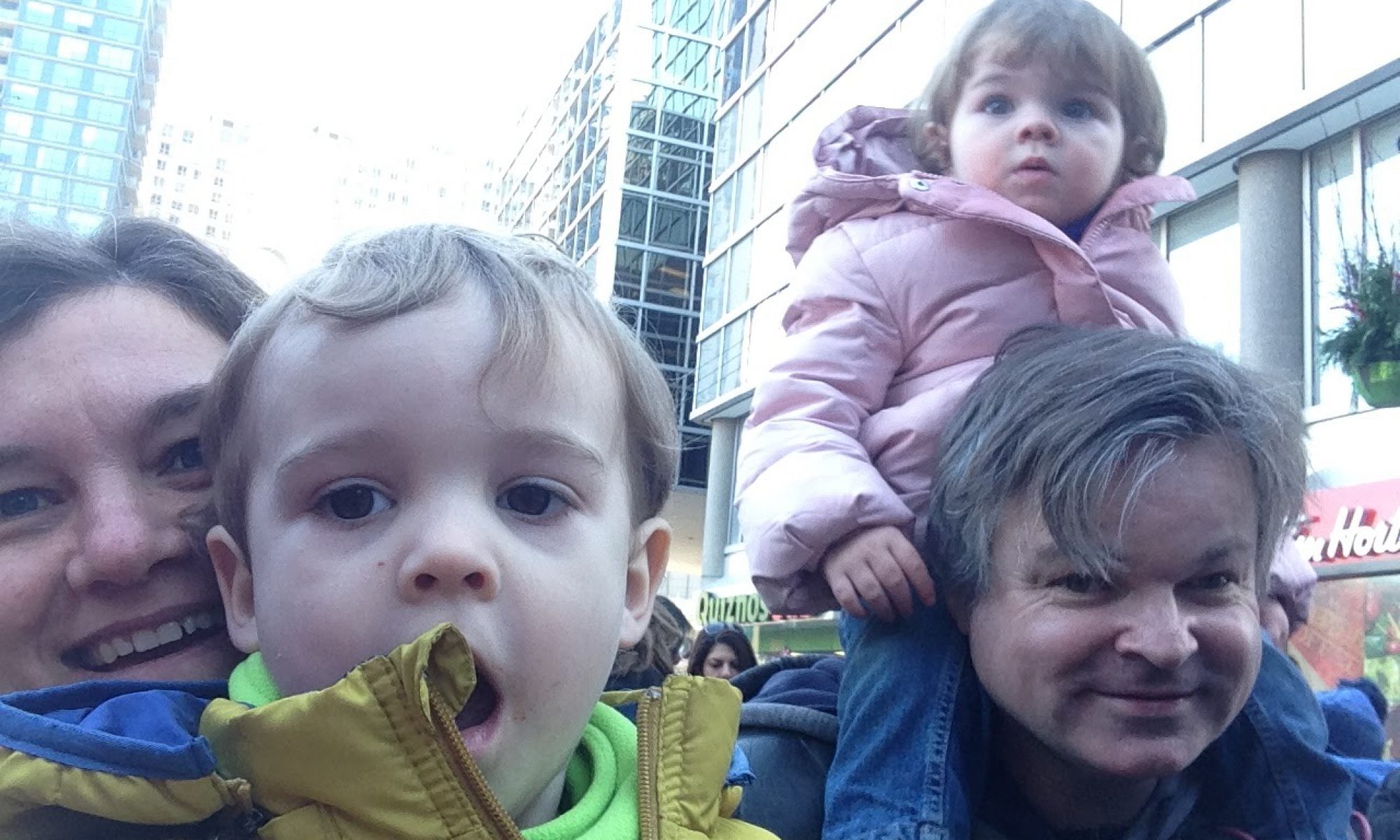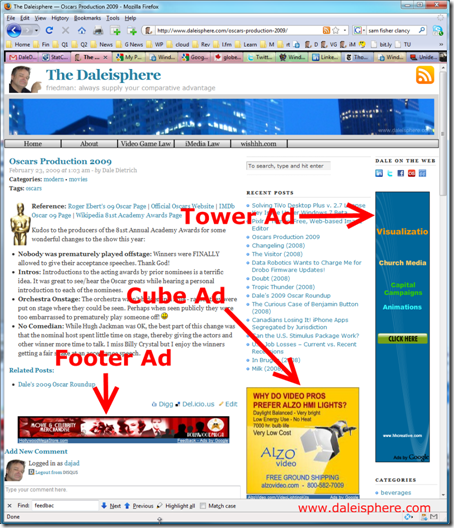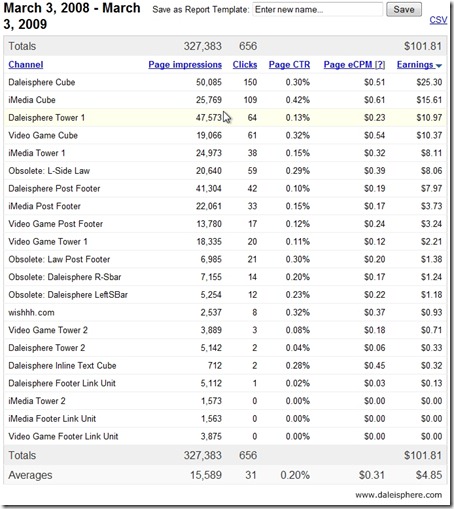 I signed up for Google AdSense on April 4, 2008. It took several weeks to sort it out and to slowly integrate the ads into The Daleisphere and my two professional blogs. After some initial testing, I had them implemented by early June 2008.
I signed up for Google AdSense on April 4, 2008. It took several weeks to sort it out and to slowly integrate the ads into The Daleisphere and my two professional blogs. After some initial testing, I had them implemented by early June 2008.
Round about March 3, 2009 I cleared my first $100 in AdSense revenue! Whoo hoo! That’s $100 in 10 short months – roughly 30 cents per day.
No Text or RSS Ads at First
My biggest mistake, it seems, was to decide not to use the text-based Google Ads – like the ad you can now see at the top of this post (just under the Categories and Tags). I think blogs littered with AdSense text-ads look hideous. I wanted my ads to be presented tastefully. Hence, for the first 10 months I opted for image-only ads.
Note: My sites only became eligible for RSS Feedburner ads in January 2009. So no significant revenue came in from that source.
Basic Structure of Ads
As demonstrated in the image below, for most of those ten months, I had each of my sites set up such that there were three primary image-based ad types (channels, in AdSense parlance) embedded within any given post:
- tower ads (120 x 600 down the right column);
- cube ads (250 x 250 in the middle column); and
- footer ads (468 x 60 under a post – before the comments).
Google AdSense allows you to categorize your ads into ‘channels’ so you can see exactly how much revenue was generated from each channel. In the report below, you can see exactly how much was earned from each ‘channel’/image-ad placement, per site:
When I aggregate the totals for the three ad/channel types across my three sites, the results are as follows:
|
clicks |
revenue earned |
revenue per click |
|
|
tower ads |
122 |
$21.31 |
17.5 cents |
|
cube ads |
320 |
$51.28 |
16 cents |
|
footer ads |
92 |
14.94 |
16.2 cents |
As you can see, the cube ads were the most lucrative, representing 51% of all ad revenue. These three ad-types generated 86% of the revenue. The other 14% was made from 11ish other ad types that I experimented with (mostly in the first couple months).
You can also see from the chart above that Google AdSense only pays when a user clicks on an ad (it seems that 1 ad click generates about 16 cents – so, please, click away! 🙂 ).
The results:
- Of the 327,383 ads served up from my sites during that period, I was paid for just 656 clicks.
- I earned 16.5 cents per click;
- I earned $1 per 3,274 ads served
- I earned one penny per 33 ads served
- 11 page views were needed to generate 1 penny (assuming 3 ads per page)
- on average, my sites need to serve 166 pages to generate one ad click
- 1,100 page views were needed to generate $1.00
- I earned 53 cents per post (I wrote 187 posts during that period)
At this rate it would take:
- 109,000 page views per month (10 x current rate) to earn $100 per month
- 1,090,000 page views per month (100 x current) to earn $1,000 per month
- 10,900,000 page views per month (1,000 x) to earn $10,000 a month.
It seems I have my work cut out for me if I want to make a living at this! 🙂
Moving Forward
After discussing these dismal results with Dave Zatz, he suggested I abandon my text-free ad purity and run at least one text-based ad per page. The result – the text ad you see in this post above and after the first post on the home page. Since I can place only three AdSense ads on a page, I replaced the prior AdSense footer ad with an Amazon.com ad.
It’s been 7 weeks since I made that change. As of April 21, 2009 my sites generated $50 in revenue in those 7 weeks – that’s roughly a 600% week-to-week increase!
Some of that, no doubt, has to do with my slowly increasing uniques and page views. In the early days I was excited when I topped 100 page-views in a day. I’m now averaging about 1,000 page views a day. Whatever the reason, the text-based AdSense ads are clearly better revenue earners than image-based ads alone. So, I’ll be keep at least one of them per post going forward.
[April 22, 2009 Update: Taking a quick look at my AdSense reports on April 22, I notice two significant details:
- Tower Ad Comeback: My tower ad revenue has increased substantially since March 3 and is about equal with the text-based ad revenue I’m getting.
- Higher Text-ad per-Click Revenue?: The per-click revenue generated from text ads is substantially higher than for image-based ads. It took only 170 clicks since March 3 to earn $50 compared to the 656 clicks needed to earn my first $100 when I used only image-based ads. Perhaps I’m not getting a higher click-through from my text ads (as I had expected). Rather, it could be that the per-click pay-out is higher for text ads].
I’ll report back when my second $100 is earned. At the current rate, my second $100 should be earned by the end of June 2009.
Note Re: Amazon Link/Ad Revenue
You’ll also see a few Amazon ads around my site too. They pay out only when a reader both: (i) clicks through the ad; and (ii) buys a product from Amazon. I generated approximately $50 from those ads and in-post links over the first year. Probably 50% of my Amazon revenue comes from my iPhone App development text book recommendations in my ‘iPhone App Development – Where to Start’ post



You better check your Google Adsense agreement. I think they frown on sharing this sort of granular revenue data. 😉 It's worth pointing out, Google Ads are generate purely click-based revenue. While something like Amazon is a commission on sales. Higher, guaranteed (sort of) revenues are generated via pay per impression – each time an ad is served you make money. Of course, these services are harder for small publishers to latch onto. I think Adsdaq takes just about everyone and you can set a price, then roll into Google. The Rubicon Project may also tap into some CPM services. I personally use Technorati Media as my primary ad service, then roll into Adify, into Adsdaq, and then Google for my three main ad units.
It's worth pointing out, Google Ads are generate purely click-based revenue. While something like Amazon is a commission on sales. Higher, guaranteed (sort of) revenues are generated via pay per impression – each time an ad is served you make money. Of course, these services are harder for small publishers to latch onto. I think Adsdaq takes just about everyone and you can set a price, then roll into Google. The Rubicon Project may also tap into some CPM services. I personally use Technorati Media as my primary ad service, then roll into Adify, into Adsdaq, and then Google for my three main ad units.
Exactly how does the 'roll into' process work. I insert the script directly into my templates. Do these other services provide you with modified scripts that do the 'rolling in”? I did look into the service you use back in February and I'll need to increase my traffic by 10 times (if memory serves) before I would qualify.
I don't believe I've looked into the others, but I've never understood the 'rolling in' process and how much effort it would take to make that happen.
Very informative post and will help someone like me who has started out now and yet to sign up for google adsense. Would surely incorporate your inputs. Also would like to know if there are better alternatives to google adsense?
I can't ad any more than what Dave did two comments above. But Dave's site has 10 times the traffic of mine (if not more). He qulifies for ad programs that I don't. That said, I still need to sift through his suggestiosn when I get a chance to see if any of those alternatives will work for me.
Good luck Rajeev!
Most “ad tags” allow you to supply backup ad units – either 100% remnant or you can divvy it up. When Technorati runs out of inventory, I roll 100% into Adify which rolls 100% into Adsdaq which rolls 100% into Google. The way I'm daisy chaining them together probably makes my load times take a hit, but I think it's working out OK. I also use Linkworth in the sidebar for rotating text links – I've been pleased with that particular service from them, but they have some other, sketchy ones I'd stay away from (like paid posts).
Dale, those are interesting results – especially the change in revenue with text ads and commission on Amazon.com sales.
To what do you attribute the resurgence in tower ad revenues?
No idea – re tower sales … no idea at all.
How does this comment appear?
I thought that Google is prohibiting in their terms of use to have their ads server together with ads from other providers on the same page. Basically what you're doing now with Google and Amazon.
Am I mistaken on that?
Not so Karim:
You can read their policies here:
https://www.google.com/adsense/support/bin/answ…
where they say:
———
Competitive Ads and Services
In order to prevent user confusion, publishers may not display Google ads or search boxes on websites that also contain other ads or services formatted to use the same layout and colours as the Google ads or search boxes on that site. Although you may sell ads directly on your site, it is your responsibility to ensure that these ads cannot be confused with Google ads.
———
So long as the ads are not formatted to use the same layout and colours as Google ads and are not confused as Google ads you are good to go. What you cannot do is use more than three Google ads on one page. But you couldn't even if you tried. Google detects such attempts and blocks any attempted fourth ad.
…Dale
Good article…..
the first hundered is just the start. now it would be less months going forward. Also a word of advice- put the cube above the fold or towards left at start of articlle. you would make nice bucks. dont worry about look and feel………most people does not complain
Hi Dale,nJust landed here through a google query.nThis is a dated post, and I am sure, you will be making much more than $100 nowadays.nBut did you know, that it is against Google Terms of Service to share your adsense incomes details like CTR, eCPM with other. Google deals very heavily with publishers violating this condition.nI would suggest you to take down this info from the post. Otherwise you risk your Adsense account getting banned.